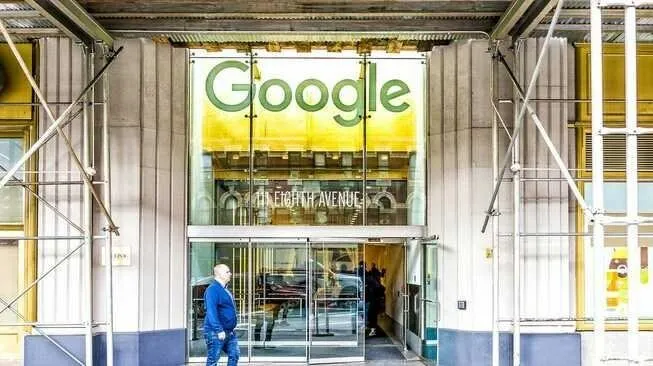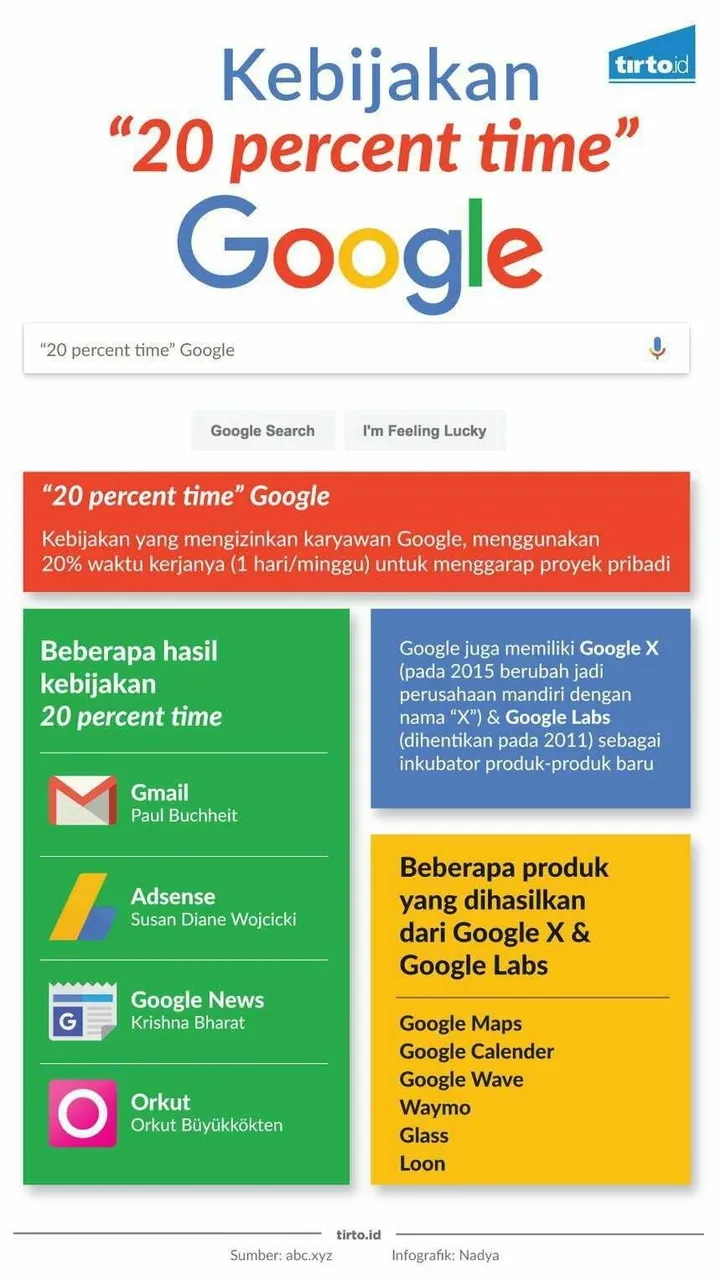
Google, a technology company pioneered by Larry Page and Sergey Brin successfully slaughtered on the stock August 19, 2004. Google gained fresh funds worth $ 1.9 billion. After the historic IPO, Page and Brin released Founders Letters and IPO Letter. Both said they "encourage employees, in addition to working on their regular projects, to spend 20 percent of their work hours working on what they think is beneficial to Google."
In the letter, this policy can "empower Google employees to be more creative and innovative." In the Founding Letter it includes 20 percent policies equivalent to one day out of five days a week when Google employees work. Monday through Thursday, Google employees work according to their obligations, then on Friday he can do any work according to interest.
Also read:
Do not be Evil, Knife Double Eyes Google's Slogan
There is a considerable amount of 20 percent policy results to give birth to major products and services from Google. Examples of such services are Gmail, the fruit of Google employees named Paul Buchheit, Adsense service by Susan Diane Wojcicki who is now CEO of YouTube), Google News by Krishna Bharat, and Orkut by Orkut Büyükkökten.
Adsense and Gmail, as a product generated by a 20 percent policy, are Google's premium products. As much as 25 percent of Google's revenue is contributed by Adsense. As of 2016, there were 1 billion active Gmail users worldwide. In addition, Google's 20 percent policy can be used for simple projects.
Also read:
Email Discovery and the Controversy of Its Creators
Bharat Mediratta, Google's software engineer, is taking advantage of Google's 20 percent policy. Through his writings in The New York Times, it is implied that this policy can begin even without Google's budget and direction. This work is purely the creativity and will of each employee. Mediratta then created a project called Testing, an educational project about how application developers perform better coding.
There are also Nat and Lo, two Google employees who open channels on YouTube as part of a 20 percent policy realization. On the channel, Nat and Lo, exploring everything about Google, became a popular-style video of everything that works behind the Google search engine.
Google's 20 percent policy matches the growing trend in the millennial world. MTV Insight, a marketing research firm, as Fast Company says, says 78 percent of millennials believe owning or doing side projects, such as Google's 20 percent policy provides, can help millennia have better or even different careers than what they do this now.
Laszlo Bock, in his book "Work Rules" as proclaimed Business Insider, said not all Google employees take advantage of this policy. Bock calls only 10 percent of Google employees taking advantage of this. One of the reasons why few people take advantage of the 20 per cent policy, as Christopher Mims has to say through Quartz, because employees have trouble avoiding their mandatory jobs instead of working on an interest-like side project.
Bock said that the actual 20 percent time provision is too much. According to him, if an employee has a side project, he will only take between 5 to 10 percent until the project undertaken has considerable implications.
Googlers who take this policy, if the project is attractive, can make it a career and moncer income. Paul Buchheit, the creator of Gmail and Google's 23rd employees, one of them. Gmail, a side project, successfully amazed Google officials. He then led the process of creating web-based email services and with the help of a more massive side of Google, not just a side project. Predictably, for the success of Gmail, it now has a wealth of $ 600 million.  Infographic Policy 20 percent time google
Infographic Policy 20 percent time google
From the fact that the number of employees using this policy, speculation is growing. The 20 percent policy has died even though Google has not explicitly disclosed it. One indicator is what revealed Marissa Mayer, a former employee of Google and former Yahoo CEO. According to him, as quoted from the Business Insider, is not a free project that uses 20 percent of working hours, but 20 percent of the time used for "things that must be done outside of regular work." That is, Google workers are said to have worked 120 percent of should.
Mims calls that this policy is still there. However, it now needs tighter approval. A Google technician who wants to take, for example, needs to get the blessing from the manager. Now there is also a team productivity assessment by Google. Instead of taking care of side projects, employees prefer to do their duty to escape judgment.
Jason Tedjasukmana, Consumer and Corporate Communication Google Indonesia, through an instant message to Tirto, said explicitly that this policy is still running. According to him, if Google employees want to take advantage of the 20 percent policy, he just register. Unfortunately, Jason did not specify how the registration process. When asked if any Google Indonesian employee was taking advantage of this policy, Jason simply answered "maybe."
Bruce Tulgan, founder of a management training firm called RainmakerThinking, implicitly mentioned that a 20 percent policy working hour can be a simultaneous fruit for Google. Employees may prefer to work on side projects rather than mandatory jobs. Tulgan said that if employees who use the policy have an entrepreneurial spirit, Google will "lose potential employees." The reason, not all side projects done can amaze Google officials, as experienced by Paul Buchheit through Gmailnya. This resulted in the absence of full support from Google which then makes the employee very likely to think to leave the company.
One way to avoid losing an employee, Donald F. Kuratko, a business professor at Indiana University, is "to provide a special place in the company for employees who bring side projects and companies must think about the right thing to do."
Also read:
The dark side of the Google Search Engine
In addition to the 20 percent work-hour policy, Google has two innovation incubators, Google Labs and Google X. Google Labs is a Google-generated page displaying projects that are still in the development stage, one of which comes from a 20 percent policy. Employees who make a side project and it turns out the project has major implications, will be more seriously worked on by Google. Eventually, the project goes to this special page. Gmail, one of them. Unfortunately, in July 2011 Google turned off Google Labs.
Meanwhile, Google X, is Google's secret research and development facility, which later became an independent company called "X" in October 2015. Google X generated a lot of high-level innovations, such as Waymo, Google's swift car, Glass, Google smart glasses, and Loon, the project of providing internet access in the interior.
One of the most successful products from Google X is Google Brain, a machine learning, created to improve the quality of human life. The project, which was initiated in 2011, is a project coached by Jeff Dean and Greg Corrado, is a Google employee and Andrew Ng, professor of artificial intelligence from Sanford University.